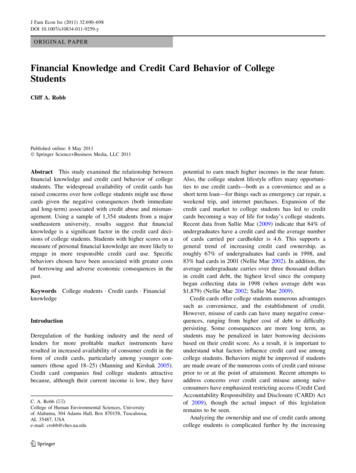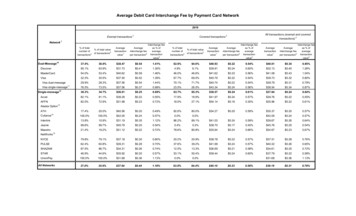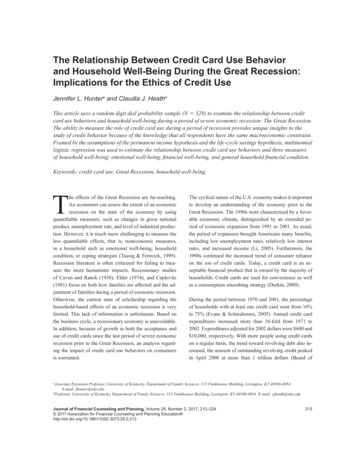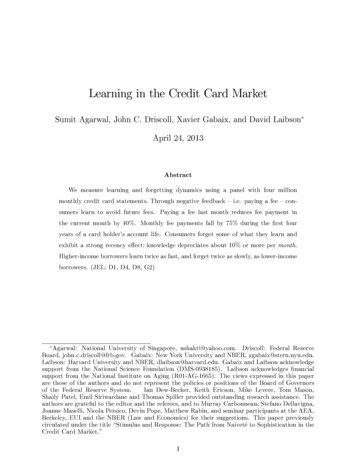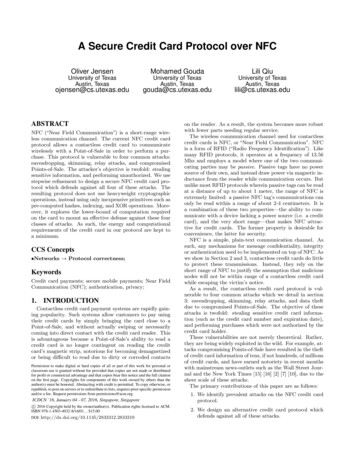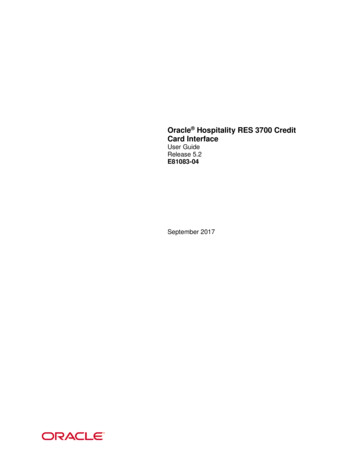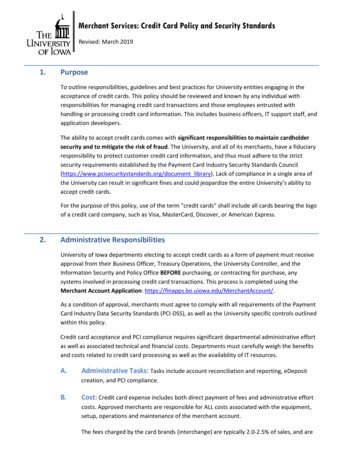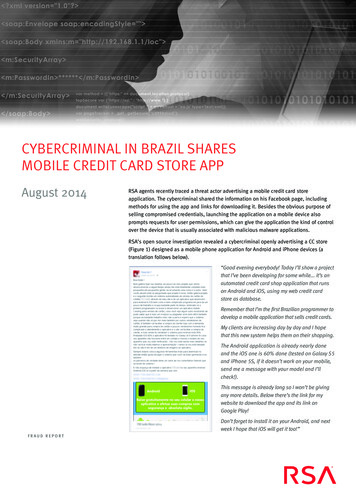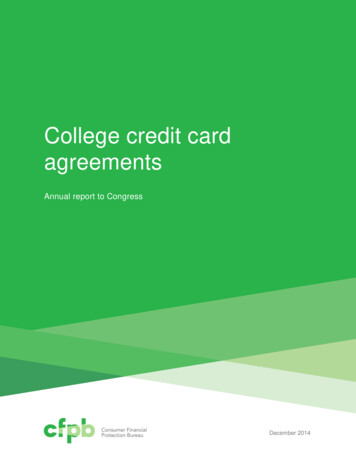
Transcription
College credit cardagreementsAnnual report to CongressDecember 2014
Table of contentsTable of contents. 21. Introduction . 42. Summary of findings . 83. College credit card results . 103.1 Issuers . 113.2 Agreements . 143.3 Partner entities . 183.4 Account volume . 213.5 Payments. 274. School disclosure of credit card agreements . 304.1 Institution selection methodology . 314.2 Agreement accessibility methodology . 314.3 Results. 325. Debit card and checking account agreements. 345.1 Agreement types . 355.2 Public disclosure . 365.3 Compliance activity . 392ANNUAL REPORT TO CONGRESS: COLLEGE CREDIT CARDS
Appendix A: . 40College credit card agreements in effect in 2013 . 40Appendix B: . 88College credit card agreements terminated in 2012 . 88Appendix C: . 100Corrected information for UMB agreements . 100Appendix D: . 104Year-end open accounts by issuer 2009-2013 . 104Appendix E: . 107New accounts by issuer 2009-2013 . 107Appendix F: . 110Agreements with highest year-end open account volume 2013 .110Appendix G: . 111Agreements with highest new account volume 2013 . 111Appendix H: . 112Issuer payments 2009-2013. 112Appendix I: . 115Agreements with highest issuer payments 2013. 1153ANNUAL REPORT TO CONGRESS: COLLEGE CREDIT CARDS
1. IntroductionThe Credit Card Accountability, Responsibility and Disclosure Act (“CARD Act”) requires theConsumer Financial Protection Bureau (the “Bureau”) to submit to the Congress, and to makeavailable to the public, an annual report that lists information submitted to the Bureauconcerning agreements between credit card issuers and institutions of higher education orcertain organizations affiliated with such institutions. 1 This report refers to these agreements as“college credit card agreements” or simply “agreements.” 2 Affiliated organizations includefraternities, sororities, alumni associations, or foundations affiliated with or related to aninstitution of higher education.This is the fifth annual report pursuant to the CARD Act. The Federal Reserve Board submittedthe first two reports. Pursuant to Title X of the Dodd-Frank Wall Street Reform and ConsumerProtection Act of 2010, responsibility for collecting data and submitting to the Congress annual1The mandate is at Section 305(a) of the CARD Act, Pub. L. No. 111–24, § 305(a), 123 Stat. 1734, 1749-50 (2009).Section 305(a) amended Section 127 of the Truth in Lending Act. The provision is codified at 15 U.S.C. § 1637(r).2It refers to credit card issuers as “issuers,” to institutions of higher education as “institutions,” and to organizationsaffiliated with such institutions as “affiliates” or “affiliated organizations.”4ANNUAL REPORT TO CONGRESS: COLLEGE CREDIT CARDS
reports regarding college credit card agreements transferred from the Federal Reserve Board tothe Bureau on July 21, 2011. The Bureau has since submitted two reports. 3Title III of the CARD Act contains a number of provisions designed to provide protections tocollege students and younger consumers. For example, the Act restricts the marketing of creditcards to college students on or near college campuses or at school-sponsored events byprohibiting the use of gifts or any tangible items to induce students to apply for credit cards. 4 Inaddition, the Act prohibits the marketing of prescreened offers of credit to a consumer under theage of 21 without the consumer’s consent. 5 The Act also prohibits credit card issuers fromextending credit to persons under age 21 without a written application demonstrating theconsumer’s independent ability to make payments or a cosigner age of 21 or over with the meansto make payments. 6 The Bureau’s 2013 report on the CARD Act addresses the effectiveness ofthese provisions in protecting younger consumers. 7Section 305 of the CARD Act was intended to bring greater transparency to the college anduniversity credit card market. Implementing regulations require that credit card issuers submitto the Bureau each year the terms and conditions of any college credit card agreement that wasin effect at any time during the preceding calendar year between an issuer and an institution of3The earlier reports are available at http://files.consumerfinance.gov/f/201312 cfpb report college-credit-cardagreements.pdf andhttp://files.consumerfinance.gov/f/201210 cfpb report College Credit Card Agreements.pdf.415 U.S.C. § 1650(f)(2).5This prohibition is stated as an addition to the Fair Credit Reporting Act. It is codified at 15 U.S.C. §1681b(c)(1)(B)(iv).615 U.S.C. § 1637(c)(8).7The Bureau’s 2013 CARD Act report is at http://files.consumerfinance.gov/f/201309 cfpb card-act-report.pdf.5ANNUAL REPORT TO CONGRESS: COLLEGE CREDIT CARDS
higher education. 8 The same requirement applies to agreements between an issuer and anaffiliated organization of the institution, such as an alumni organization or a foundationassociated with the institution. 9Issuers are required to submit the following information with respect to each such agreement:(1) the number of credit card accounts covered by the agreement (“college credit card accounts”)that were open at year-end; (2) the amount of payments made by the issuer to the institution ororganization during the year 10; (3) the number of new college credit card accounts covered bythe agreement that were opened during the year; and 4) any Memorandum of Understanding(“MOU”) between the issuer and institution or affiliated organization that directly or indirectlyrelates to any aspect of the agreement. 11 Appendix A provides a detailed listing of all dataprovided by issuers for 2013. Institutions of higher education are also required to makeagreements available to the public, a requirement discussed in more detail in Section 4 of thisreport. 12As part of its effort to achieve greater transparency, Congress directed the Bureau to issue areport each year on the information and documents provided by card issuers, including thenumber of new accounts opened pursuant to agreements between card issuers and colleges anduniversities and the compensation paid by issuers to these institutions. This report is based onthe information and agreements submitted to the Bureau by credit card issuers. The8See 15 U.S.C. § 1637(r) & 12 CFR 1026.57(d); see also 76 FR 79768 (Dec. 22, 2011).9In some cases, issuers submitted to the Bureau agreements with other types of organizations, such as fraternities,sororities, and professional or trade organizations that relate to the issuance of credit cards to college students.Such agreements are included in this report and categorized as agreements with “other organizations.”10All payments included in this report are rounded to the nearest dollar.11See 12 CFR. 1026.57(d)(2).12This obligation applies to “any contract or other agreement made with a card issuer or creditor for the purpose ofmarketing a credit card.” 12 CFR 1026.57(b).6ANNUAL REPORT TO CONGRESS: COLLEGE CREDIT CARDS
information is current as of the end of 2013. 13 Information included in this report also isavailable on the Bureau’s public website at www.consumerfinance.gov.In the interests of transparency, this report also provides information on the extent to whichinstitutions are making these agreements available to students or other affected members of thepublic. It also reports on agreements between issuers and institutions that cover depositaccount and debit/prepaid cards, and addresses whether these are available to students andother affected parties. 1413Issuers were required to make their fifth annual submission by April 1, 2014. This submission comprised collegecredit card agreements to which the issuer was a party during 2013 and information regarding payments andaccounts as of December 31, 2013.14The Bureau’s statutory objectives include “ensuring that, with respect to consumer financial products andservices . . . consumers are provided with timely and understandable information to make responsible decisionsabout financial transactions, [and] markets for consumer financial products and services operate transparentlyand efficiently to facilitate access and innovation.” 12 USC 5511(b)(1) & (5).7ANNUAL REPORT TO CONGRESS: COLLEGE CREDIT CARDS
2. Summary of findingsThe report makes a number of findings: Continuing an established trend, the number of colleges, universities, and affiliatedorganizations (like alumni associations) sponsoring credit card programs decreased in2013; The overall number of accounts issued under such programs also decreased in 2013,which again continues a well-established trend; Similarly, the amount of compensation paid by issuers to institutions and affiliatedorganizations pursuant to these agreements fell from the prior year, as it has since atleast 2009; For the first time, in 2013, more than half the agreements that issuers reported to theBureau were between an issuer and an alumni association. Direct agreements betweenissuers and colleges or universities, therefore, account for a decreasing share of thereported agreements; Although the overall number of open accounts issued under these agreements has fallenconsistently since 2009, the number of new accounts originated in a given year has beenincreasing since 2012. Nearly three-quarters of this new account growth, however, isaccounted for by agreements between issuers and alumni associations, indicating thatmost new accounts likely are issued to alumni, not to students; Based on the Bureau’s review of college and university websites, most institutions ofhigher education do not make copies of these agreements available on their websites tostudents and other affected parties. In rare cases, institutions provided guidance on howto obtain their agreements with credit card issuers; and8ANNUAL REPORT TO CONGRESS: COLLEGE CREDIT CARDS
Although the Bureau lacks comprehensive data on the point, there are indications thatthe number of agreements between institutions and checking account, debit card andprepaid card providers has been increasing, even as the number of credit cardagreements has declined. Furthermore, as a general matter, issuers and institutionshave not chosen to disclose in a readily accessible manner these deposit account, debitcard, or prepaid card agreements.These findings are subject to a number of limits. Some college agreements cover other financialproducts besides credit cards, such as deposit accounts, so payments made by issuers underthese agreements may not relate solely to credit card accounts. In addition, some or all of theaccounts opened in connection with these agreements, even those directly between issuers andinstitutions, may have been opened by individuals who are not students, such as alumni, faculty,and staff of an institution of higher education. (Conversely, it is theoretically possible thatstudents may have opened accounts under the terms of alumni agreements.) Furthermore, cardissuers’ submissions do not include information regarding credit card accounts opened bystudents independent of a college credit card agreement, such as when a student responds to anoffer made to the general public. Finally, because issuers were required to submit all collegecredit card agreements to which they were a party a
The Bureau received 448 college credit card agreements from 26 credit card issuers for 2013. This section of the report presents data about these agree ments and compares that to data for earlier years.
